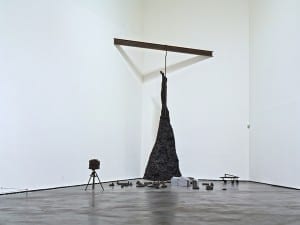Review by Paul Hardman
Bronstein is the first artist to have had the opportunity to use all of the ICA‘s available spaces for a solo exhibition. The three main gallery areas, along with corridors and stairwells, have provided him with a puzzle that suits his own work particularly well, since the subject of much of his work is the vocabulary of Regency period design and architecture, and building that houses the ICA, Nash House, is itself a grand example of this genre. This connection between the artists work and the architecture creates a relationship that is at times ironic, charming and occasionally confusing. But it a connection that I am sure delighted the artist, and this delight shines through in the parts of the exhibition that work most successfully.
In the first lower gallery an enormous painting fills the whole of the far wall, depicting a huge regency period building and courtyard, the building has features very similar to The Mall, just outside, but this is an invented building, and this area of the gallery is in a modern white box style room, with no trace of the outer form. So Bronstein has set up a strangely artificial construct to begin with: an imagined Regency building, in a non period space, in a real Regency building. This painting functions as a stage set for a performer, who stalks around the room on her toes in long stylised strides, pausing occasionally to strike poses. She wears a yellow and black outfit designed by Mary Katranzou, which references period dress but is something quite clearly contemporary, so the effect is not of a simulation of an aspect of a previous era, but of taking apart and examining piece by piece the grammar of a language that can no longer be understood.
This kind of slow methodical examination continues with a set of drawings that are mounted on the walls at the base of the stairs and continue upwards through several stories to the top of the building. This series called Designs for the Ornamentation of Middle Class Homes (2011), is meticulously executed, as are the rest of the drawings in the exhibition, and seems to follow an internal set of rules that cause it to expand apparently towards infinity as it spirals upwards. Each drawing depicts the facade of the front of a house with empty spaces for windows and the door, above which is a small decorative panel. As one moves along the row of drawings the decoration changes, from laurel leaves, to a statue of a nymph, to a scroll motif and so on. But at some point one realises that some of the window spaces now have a curved top edge, then more windows appear, then the decorative area moves, and then it becomes apparent that the drawings are increasing in size to accommodate taller buildings. This slow process of expansion continues right the way up in a slow, slightly maddening way. Again Bronstein seems to be working through the vocabulary of the style in a way that undermines the possibility of meaning.
Some of the other drawings in the exhibition have something of M.C. Escher about them, not that they are actually ‘impossible’, but that they have something deliberately wrong about them. In once case, a large monolithic block of a building is shown from an elevated angle so that the roof can be seen, but the internal courtyard is shaped in a tight triangle, positioned off centre. It is a shape that would clearly never be made, but drawn in the correct projection and perspective Bronstein makes it look like a completely straight faced proposition. In drawings of this sort Bronstein’s dry delivery and flawless technical skill are combined to perfect effect.
The exhibition can seem slightly austere, and a little difficult to engage with at first. For example, a large cabinet against is displayed upstairs with little explanation, and seems like an empty gesture. But in fact this is one of Bronstein’s metamorphic pieces of furniture, and at certain parts of the day it is demonstrated how the object transform into other things. As one start, to get into Bronstein’s way of looking at things, the lighter side to his work begins to emerge, and his subject begins to open up. One thing the show does do is make London look different when you leave the gallery, the architecture of the city now feels more like something to be questioned and deciphered rather than a simple backdrop for daily life.
Pablo Bronstein: Sketches for Regency Living continues until 25 September 2011
ica.org.uk
Aesthetica Magazine
We hope you enjoying reading the Aesthetica Blog, if you want to explore more of the best in contemporary arts and culture you should read us in print too. In the spirit of celebration, Issue 41 includes a piece on Guggenheimn Bilbao where the Luminous Interval features internationally acclaimed artists such as Louise Bourgeois, Kiki Smith and Damien Hirst, ArtAngel’s new commission at MIF, Bruce Nauman’s retrospective at The Kunsthalle Mannheim and Cory Arcangel’s Pro Tools at the Whitney in NYC. You can buy it today by calling +44(0)1904 479 168. Even better, subscribe to Aesthetica and save 20%. Go on, enjoy!
Costumes by Mary Katrantzou
Exhibition view of Sketches for Regency Living at the Institute of Contemporary Arts from 9 June to 25 September 2011
Photos © Steve White





